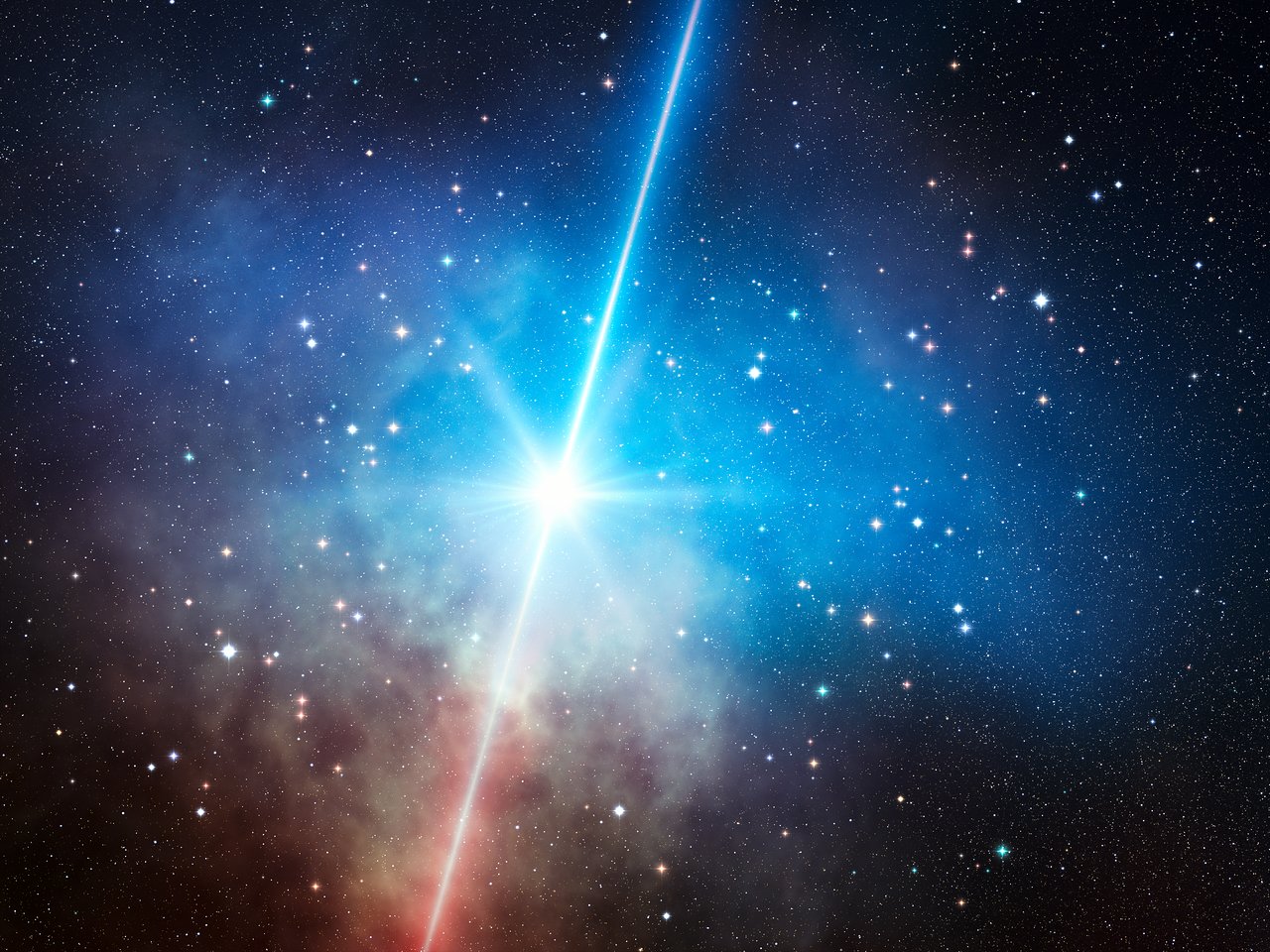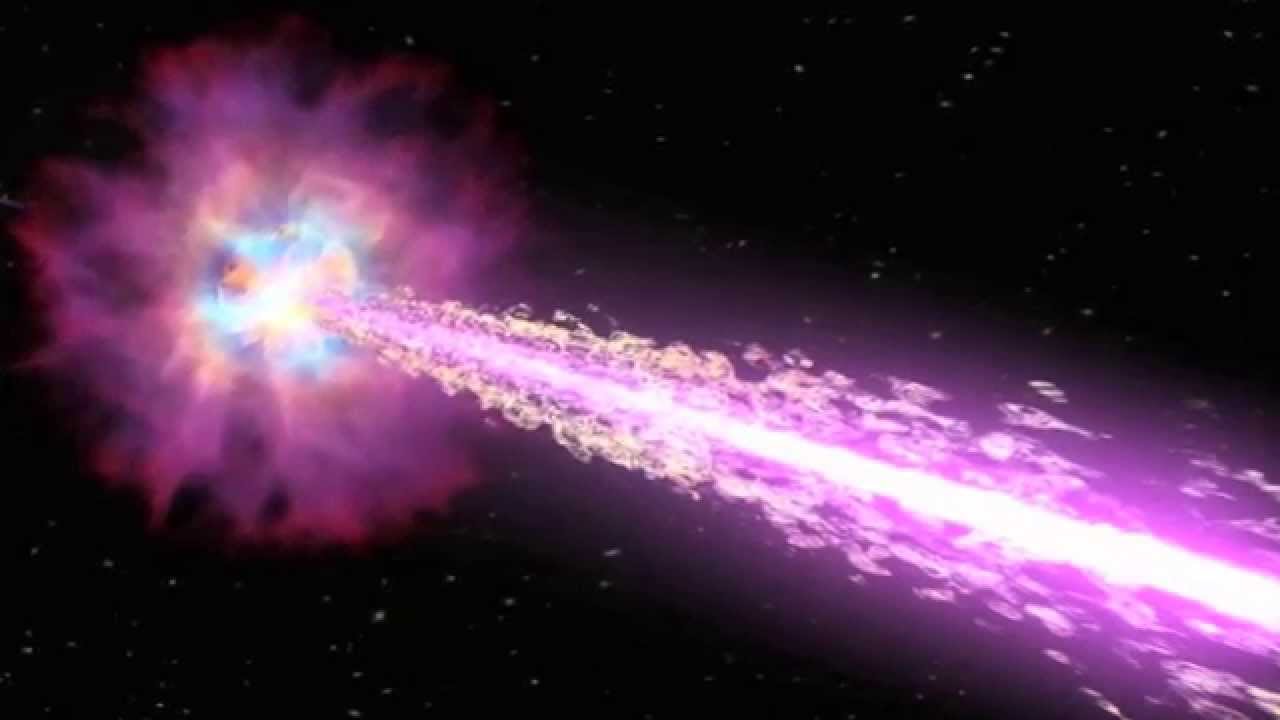"Imma Firin' mah Lazer!" GRB's in a shellnut.

Ever play-around with a strong laser pointer?
If there's one thing one will notice about a laser pointer, they are extremely potent by appearance. Shooting off a beam of the light that, in the night time, can travel visibly for several miles.
Yet, when you gander at the power of the laser, you'll notice something odd, in spite of going for incredible distances and being able to blind a person with too much exposure, they tend to yield energy only measured in the milli-watt range. A 5 MW pointer is actually right at the federal limit for how strong they are legally speaking. And even that can travel at least a mile in all nighttime conditions.
These proportions of energy usage are puny compared to that of a standard light bulb or even a flash light. So why does the laser have so much more range?
The answer lies in how it uses its energy. A Light bulb or flash light project visible light in all wavelengths, the wavelegnths then interfere with each other and as result spread out. This means the light must travel in several directions and cover a lot of space, while with a laser pointer, the beam is composed of light with the same wavelength, thus making the photons not throw each other off and thus the light directs all energy in a small area. This effect in which energy is focused can be observed just about anywhere. Such as when you block a certain portion of a hose and the water comes raging out faster and farther than before.
So what would happen if you took, say, the most powerful explosion in the universe and applied this same concept to it? Is such a thing possible? Can that amount of energy be focused by anything?
As it turns out, yes.
During the cold war, neither the USSR or USA trusted one another, not even in the simple acts of staying within rules set forth by treaties. A US satellite in the midst of it all, listened closely to the soviets activity. Or, observed it that is.
Each side was concerned that the other could be holding nuclear test on the back of the moon, where they wouldn't be detected but would still show the same effects as they would in space, where it was agreed no nuclear weapons would be tested. And eventually the satellite got a signal, but not one anyone was expecting. It was instead longer lasting and receded in waves instead of a simple bell curve graph of radiation intensity.
For the longest time, the sources of these, say, burst of light, including a strong dose of gamma rays, were a complete mystery. Keep in mind technology at the time was limited and couldn't give scientist an all to accurate triangulation of a sources location in the sky. But eventually with the advancement of detection systems. A new satellite was able to give quick feedback telling people where the burst were coming from. When they observed the flashes, what was found is that they always lied on distant galaxies, and by distant, I mean REALLY distant.

So now it was confirmed, these were in fact, intergalactic events, ones that were occurring, not just outside our local group, but in fact, billions of light years away.
For some perspective, the entire observable universe, (based on the point in which light not longer reaches in any form), is about 93 Billion Light years in diameter. So these things, these so called gamma ray burst, can be seen from distances equaling around half the diameter of the entire visible universe.
"But, how?"
Is exactly what astronomers wondered at the time of seeing this. How could something this powerful and energetic even exist?
Not even supernovae yielded this kind of energy. So what could?
One idea that came into mind was black holes, given the fact that they were responsible for quasars, already known events that emitted more light than entire galaxies. Could GRB's be some sort of temporary quasar?
Not exactly, but black holes were part of the process.
As it turns out, GRB's are in fact the energy of a hyper nova, (a high energy supernova), focused into twin beams shooting out from the former stars poles. And this was the responsibility of the black hole that formed at the center immediately following its collapse. The collapse of material onto the black holes surface causes a somewhat unknown process in which matter and energy are forced outwards in two opposing directions.
And what do you get? Well, in metaphorical terms, a waterfall through a hose.
The power of a high tier supernova focused into two gamma lasers.
Think about that last sentence for a second, now remember that this is a real thing happening all around the universe. And when they are pointed directly at us, that is when we get to detect them. And in some cases, even see them.
Yes, in spite of their tremendous distance, some GRB's are in fact visible from here on earth, they only last for a few seconds, maybe 5-20 at their peak, and then a view visible minutes of dim light before fading away. But when someone is lucky enough to see one with their naked eyes, they are in for something truly shocking. Seeing a light perhaps as bright as any surrounding star pop into view, and then, gone.
And in case you were wondering, the most powerful burst ever seen was recorded in 2013, and had an energetic yield equal to that of the Sun's total energy output. . . if it lived 850 times longer than it will. . .

But strangely enough, there are actually two kinds of GRB's. One is the normal kind with stars imploding and then bursting. But there's another form of massive gamma output in twin beams out there. And even though it is around equal in level of brightness for a moment, it is a type dubbed the, "Mini GRB", based on how they only last for fractions of a second.
This kind actually has nothing to do with supernovae though, instead it occurs through a process in which two neutron stars collide with one another, creating a black hole out of their combined mass, with a little left over neutronium, (hyper-dense neutron star material), orbiting the black hole for a second before getting rapidly spun and converted to energy within seconds. Energy of which is then shot out as gamma rays in opposing directions, just like a GRB. The properties that lead to this may be difficult to understand without knowing exactly what neutron stars are and what they're made out of, perhaps I'll do a piece on them in the near future.
And on a final note, perhaps if you've ever heard anything about gamma ray burst, it's the paranoia that one could eliminate humanity in the unknown future. However, truth be told, this is tremendously unlikely.
There are only two candidate stars close enough to damage the atmosphere, the range is around 7000 light years. These include a wolf-rayet, (really hot and massive) star called WR 104, and eta Carinae, a equally distant and mysterious powerful star that almost exploded 100 years ago.
In order to even have any effect on us, these stars would need to have one of their twin beams aimed right at us, which is already pitting the odds against them. Apart from that, they're on the edge of the danger radius, and new research suggest our atmosphere is much tougher then it may have been when the Earth potentially got fried by a burst many millions of years ago. (Which may very well have caused an mass extinction).
All around though, Gamma ray burst are quite simply spectacular events. The very existence of condensed star bombs is something worth talking about, but the degree to which they dial up all measurements of amazing and powerful is something else. The way they eject physical matter outwards at 99.99999% the speed of light, the way they can create temperatures estimated at a trillion degrees. The way they, within just a few seconds mind you, expel energy that would eclipse the entire outputs of stars over billions of years. And, even though is means just about nothing in a real world sense, the joule count on a very average star GRB is around 3.1 x 10^51, or, 310000000000000000000000000000000000000000000000000 joules.
And just to think, they happen literally every day, all throughout the deep cosmos.

Image Origins: https://www.eso.org/public/images/eso1049a/
http://skycenter.arizona.edu/gallery/Galaxies/M81
https://www.space.com/23684-brightest-gamma-ray-burst-mysteries.html
http://www.bbc.com/earth/story/20160714-the-biggest-explosions-in-the-universe